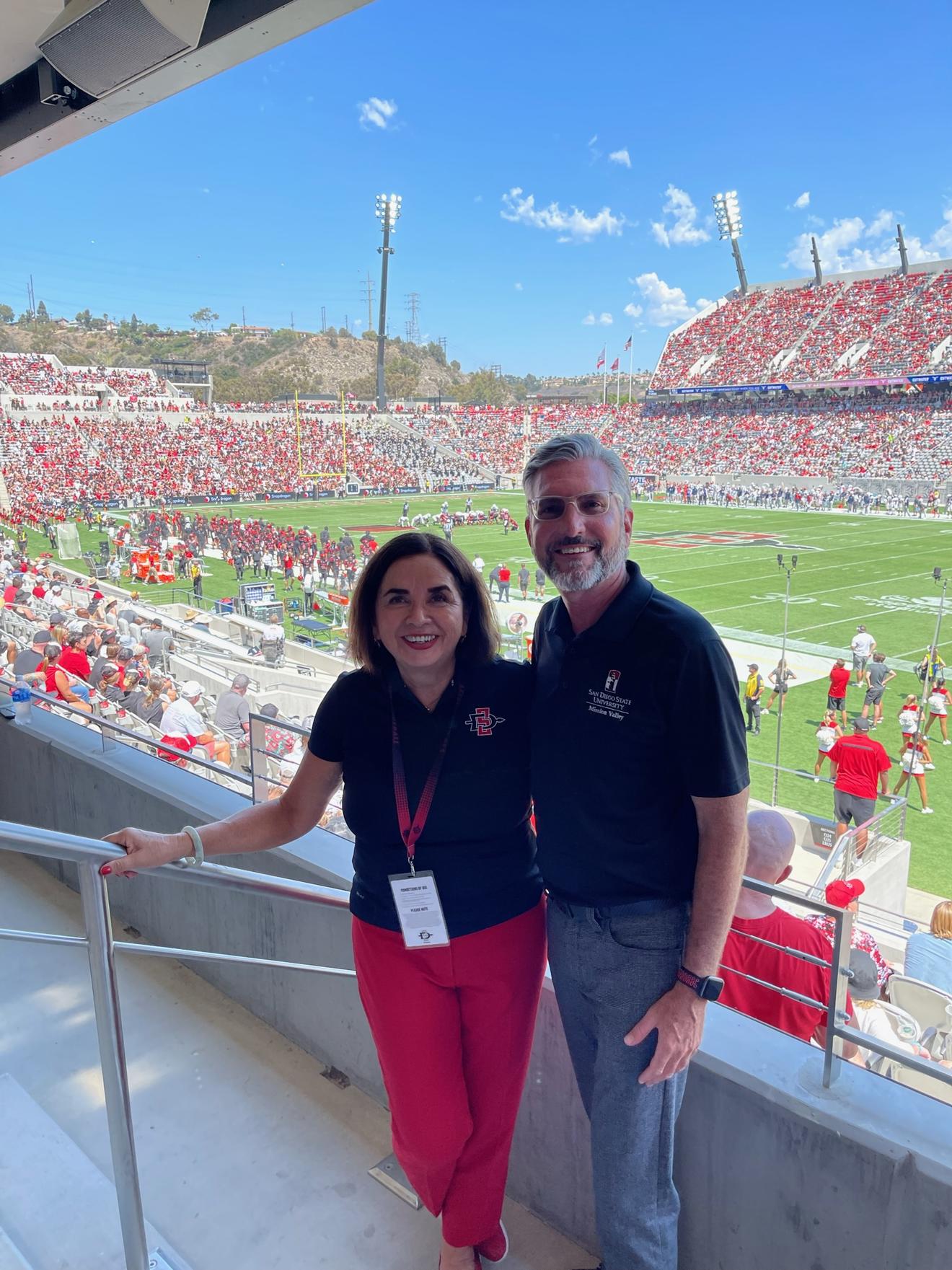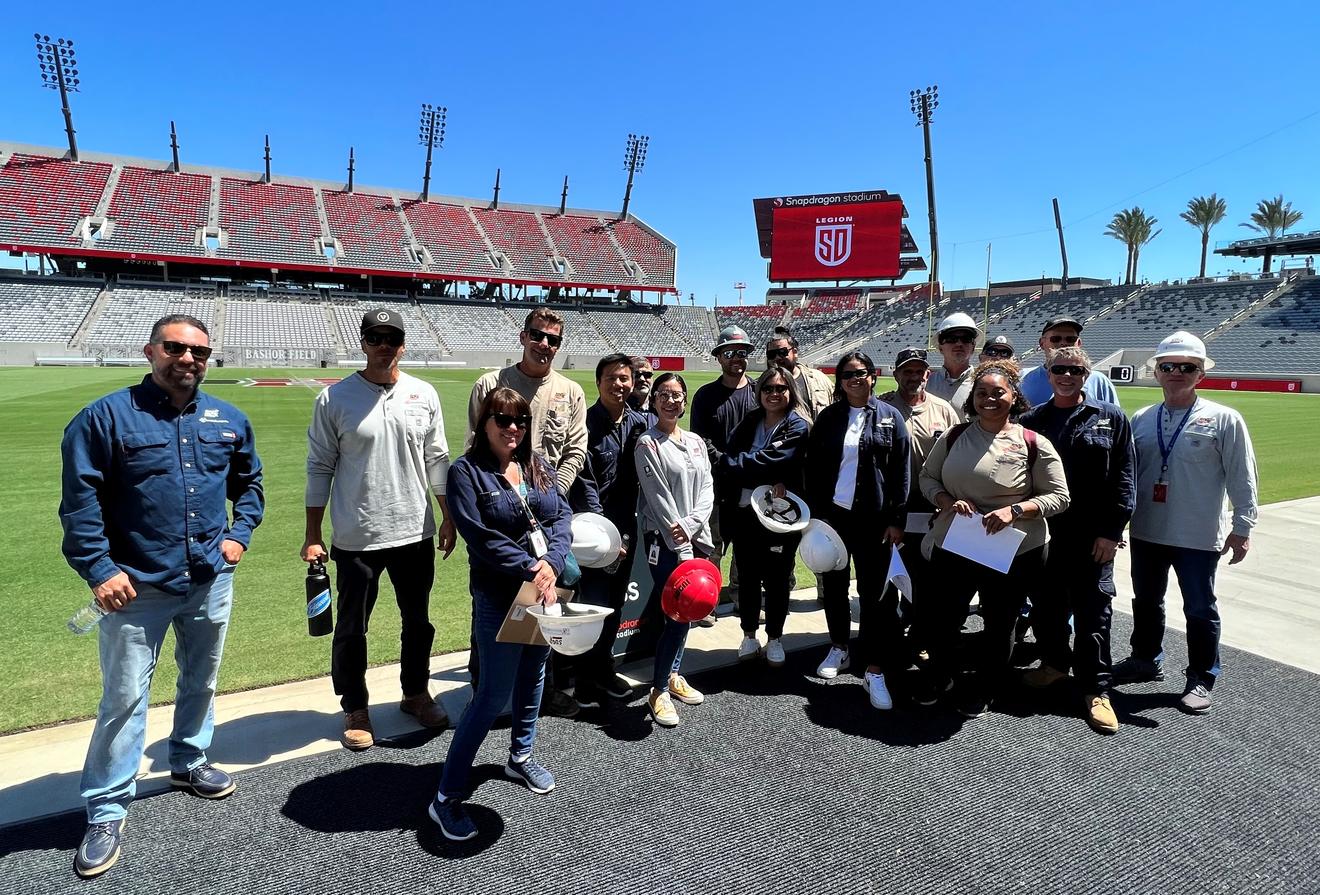For many of our employees, there was a palpable sense of pride when San Diego State University held its inaugural football game at its brand-new Snapdragon Stadium in Mission Valley last month.
While Sept. 3 will go down in history as the hottest game in recorded history for SDSU’s football team – a sweltering 105 degrees in the stands prior to kick-off – the work of some of SDG&E’s brightest minds was also on full display.
The pipes and wires that deliver natural gas and electricity to the stadium were designed and engineered by our employees – many of whom are proud Aztecs. One in ten of our employees are SDSU alumni, including Director of Electric System Planning, Alan Dulgeroff, who provided overall leadership for our role in the stadium project.
“This is a pinnacle of my passion – to see our employees rise to the occasion and provide such great enthusiasm and support to get it done in record time during a pandemic,” said Dulgeroff. “It’s a once-in-a-lifetime project where we at SDG&E are giving back to a future generation.”
To ensure that game day was perfect, our electric line workers, circuit and switch operators, troubleshooters, and gas and electrical engineers vigilantly stood to watch over the new energy infrastructure – ready for any unexpected hitch which never materialized.
Countless pieces of equipment at the new stadium – everything from lights and video boards to water heaters and air conditioners to food vendor kitchens depend on clean, safe, and reliable energy to operate. On official opening day, eclectic food offerings were being flame-broiled to perfection, and commercial refrigerators were humming – keeping libations at a thirst-quenching 37 degrees. All of the assignments that day were so tuned in that you were not aware of the operations behind it all.
A Two-Year Sprint to Get it Done
“SDG&E’s true gameday started two years earlier, when SDSU requested an accelerated electrical and gas connection, to meet the September 2022 deadline and certificate of occupancy,” said Michael Fuller, our project planning supervisor.
“The expedited schedule was a monumental task that required more than 100 of our experts to showcase their second-to-none customer service, agility, and ability to use their innovative technical capabilities to find quick solutions,” said Fuller.
In addition to the stadium, the future phases of SDSU West boast a 400-room hotel and an Innovation District with 1.6 million square feet of space for education, research, entrepreneurial, and technology programs. The site will also include about 4,600 residential units including affordable housing and accommodations for students, faculty, and staff.
The expanded use of the site, formerly Qualcomm Stadium with one of the largest parking lots in the nation, required our teams to upsize the electrical capacity from two 12-kilovolt electrical services to three. Gas requirements throughout more than doubled from the previous 2-inch-diameter high-pressure gas line connected to the site. Both gas and electric connections required new redundancies to support the much larger future footprint.
“I’m proud of the entire SDG&E team that supported the effort to bring safe and reliable natural gas through the transmission system to serve not only this stadium but the additional educational growth that will make up SDSU’s future campus,” said Norm Kohls, an SDSU graduate, and our manager of gas transmission projects and pipeline integrity.
Leaving a legacy
“From the start, SDG&E workers developed a partnership of trust with the university and their representatives, Baker Electric, Clark Development, and NV5 as they met a cascade of benchmarks and milestones – on time,” said Dulgeroff who is a major SDSU booster and mentor to SDSU engineering students.
Completing the stadium on a highly compressed schedule required an elaborate orchestration of capital improvements, transparency and flexibility, and a fluid dialogue of internal and external collaboration with planning, design, and construction stakeholders.

Over the next decade, we will partner with the California State University system to realize the envisioned 132-acre satellite campus consisting of many amenities, including bike paths, parks, open space, and conference facilities collectively known as SDSU West.
The individuals who energized the site have left a legacy. By successfully executing the first of many phases of SDSU West, our teas have laid the foundation for a transformative development that is expected to generate $3.1 billion in economic impact for our region.
SDG&E department staff that energized SDSU West:
- Electric System Planning
- Design and Project Management
- Construction Management
- Beach Cities Construction and Operations
- Customer Services (Account Executives)
- Regional Public Affairs
- Gas Operations
- Electric Engineering
- Substation Construction and Maintenance (Kearny)
- Electric Distribution Operations
